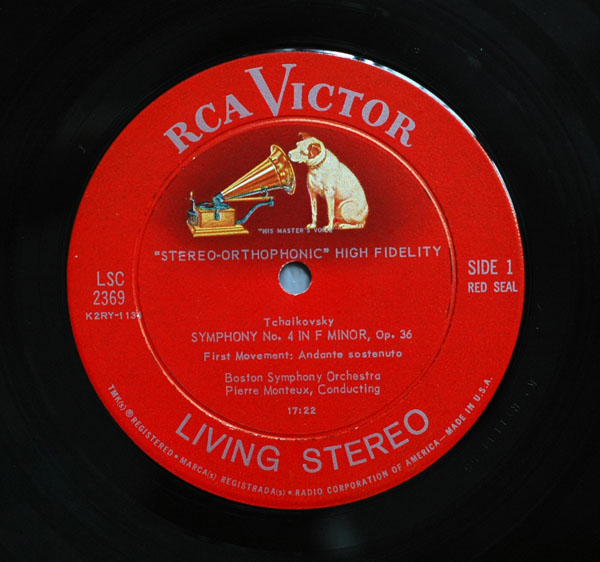Monteux/BSO - Tchaikovsky: Symphony No.4
Vinyl Rip in 24-Bit/96-kHz | FLAC tracks | Covers | RS, MU | 772 MB incl. 3% recovery
1960 | Genre: Classical | Label: RCA | LSC-2369 | US pressing
Red Seal, shaded dog label. Original pressing 4S/5S
This album was listed in TAS (The Absolute Sound) issue #32
In the Boston Symphony series of stereophonic recordings, we find this kind of orchestral arrangement, and Monteux's architectural vision in all of these performances produces a sound-world that can be breathtaking. Listen to the sweep of the last movement of the Tchaikovsky Fifth with its wonderful balance of strings, winds, and brass, the full grandeur of the piece without any sense of heaviness, and the sheer élan of the coda that leaves the listener exalted, not exhausted. Or turn to the dichotomy of brooding and extrovert energy in the opening movement of the Fourth Symphony. While we can hear superb performances of these works by conductors like Mravinsky, the Monteux Tchaikovsky symphonies are true classics, that combine wise, beautiful, powerful performances with remarkably fine sound.
( Thomas Simone )
The symphony is held together by a recurrent motif, a dramatic, hammering figure with repeated notes heard in the horns at the very beginning. This, Tchaikovsky told Mme. von Meck, "is Fate, the inexorable force that prevents our hopes of happiness from being realised …. it is Damocles' sword, hanging over the head in constant, unremitting, spiritual torment."
The drooping, descending, principal theme that follows is intended to symbolise submission to Fate; at length the composer turns from reality and sinks into dreams.
Fate, however, roughly awaken us. "So life itself is a persistent alternation of hard reality with evanescent dreams and clutchings of happiness…. This, approximately, is the 'program' of the first movement."
The second movement is marked Andantino in modo di canzone. The canzone might well have been a Russian folk song. It is a nostalgic, wistful melody played by the oboe. A broader theme in the strings provides contrast, and then the oboe tune comes back. This movement, according to the composer's letter, suggests "the melancholy that comes in the evening when we sit alone and, weary of work, we try to read, but the book falls from our hand." Gentle reminiscences crowd one's thoughts. "It is sad and somehow sweet to sink thus into the past."
In the third movement Tchaikovsky plays about among the choirs of the orchestra. The movement is a scherzo in which the strings put down their bows and pluck, as if the string body were suddenly transformed into a gigantic balalaika. There are also whistling, gay tunes in the woodwinds, and a march in the brass. This scherzo, says Tchaikovsky, "is a succession of capricious arabesques, those intangible images that pass through the mind when one has drunk wine and feels the first touch of intoxication… The imagination has free rein and has begun, one knows not why, to draw strange designs. Suddenly comes to mind a picture of a drunken peasant; a brief street song is heard. Far off, a military procession passes. The pictures are disconnected, like those which float through the mind when one is falling asleep…."
The finale depicts a peasant festival and is based on a Russian dance tune: "If you find no joy within yourself, look for it in others. Go to the people. See, they know how to make the most of their time, how to give themselves up to pleasure!" But "no sooner do you forget yourself in this spectacle of others' joy than merciless Fate reappears to remind you of yourself." This, of course, is the horn theme of the opening, which returns at the climax of the last movement. But the music gathers energy once again, and the symphony comes to a blazing conclusion.
(Alfred Fankenstein - Music and Art editor, San Francisco Chronicle)
Performed by Boston Symphony Orchestra conducted by Pierre Monteux, 1960.
Track Listing:
A1. Tchaikovsky: Symphony No.4 in F minor, Op.36 - Andante sostenuto
B1. Tchaikovsky: Symphony No.4 in F minor, Op.36 - Andantino in modo di canzone
B2. Tchaikovsky: Symphony No.4 in F minor, Op.36 - Scherzo: Pizzicato ostinato
B3. Tchaikovsky: Symphony No.4 in F minor, Op.36 - Finale: Allegro con fuoco
Tonearm: Audioquest PT-9
Cartridge: Ortofon X5-MC (Moving Coil)
Phono Cable: Van den Hul D-502 Hybrid
Pre-amplifier: Counterpoint SA 5.1 (vacuum tube Sovtek 6922)
Interconnect: balanced, Belden 1813A cable with Neutrik XLR connectors
Analog to Digital Converter: EMU 1212M (configured for balanced input +4dBu, 0 dB Gain)
Capture software: Goldwave 5.52
Post processing: ClickRepair, setting: 10, reverse, wavelet x3
Ripping policy: I always rip good condition vinyl so that the amount of click/pop will be almost none
Cartridge: Ortofon X5-MC (Moving Coil)
Phono Cable: Van den Hul D-502 Hybrid
Pre-amplifier: Counterpoint SA 5.1 (vacuum tube Sovtek 6922)
Interconnect: balanced, Belden 1813A cable with Neutrik XLR connectors
Analog to Digital Converter: EMU 1212M (configured for balanced input +4dBu, 0 dB Gain)
Capture software: Goldwave 5.52
Post processing: ClickRepair, setting: 10, reverse, wavelet x3
Ripping policy: I always rip good condition vinyl so that the amount of click/pop will be almost none





